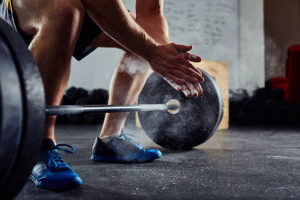The deadlift is one of the most effective and rewarding weightlifting exercises, targeting multiple muscle groups, including the back, glutes, hamstrings, and core. Done correctly, it builds strength, power, and stability. However, improper technique can lead to injuries and limit progress. Here’s a comprehensive guide on how to deadlift properly, ensuring safety and effectiveness in your weight training routine.
Benefits of Deadlifting
Deadlifts offer a range of benefits:
- Full-Body Strength: Engage nearly every muscle group, from your legs to your upper back.
- Functional Fitness: Mimics everyday movements like lifting and carrying.
- Improved Posture: Strengthens the muscles supporting the spine.
- Increased Metabolism: Heavy lifting burns calories and boosts metabolism.
- Grip Strength: Improves grip through the sustained hold on the bar.

Types of Deadlifts
Before diving into proper form, it’s essential to understand the most common variations:
1. Conventional Deadlift
- The classic style, emphasizing the hamstrings, glutes, and lower back.
2. Sumo Deadlift
- Features a wider stance and a more upright torso, reducing strain on the lower back.
3. Romanian Deadlift (RDL)
- Focuses on the hamstrings and glutes with minimal knee bending.
4. Trap Bar Deadlift
- Uses a hexagonal bar, offering a more beginner-friendly option with reduced lower back stress.
Step-by-Step Guide to the Conventional Deadlift
1. Setup: The Foundation of a Strong Deadlift
- Approach the Bar: Stand with your feet shoulder-width apart, toes under the barbell.
- Bar Placement: The bar should be over the middle of your feet, close but not touching your shins.
- Grip the Bar: Use either a double overhand grip or a mixed grip (one palm facing you, the other facing away) for heavier lifts.
- Hand Placement: Hands should be just outside your knees.
2. Posture and Positioning
- Hinge at the Hips: Push your hips back while maintaining a neutral spine. Avoid rounding or hyperextending your back.
- Engage Your Core: Tighten your abs to protect your lower back.
- Shoulder Position: Keep your shoulders slightly in front of the bar, with your lats engaged.
- Knee Bend: Slightly bend your knees to bring your hands to the bar while maintaining tension in your
 hamstrings.
hamstrings.
3. The Lift: From Ground to Lockout
- Initial Pull: Push through your heels and keep the bar close to your body as you lift. The bar should travel in a straight line.
- Engage Your Glutes: As the bar passes your knees, thrust your hips forward to stand tall.
- Lockout: At the top, stand straight with your shoulders back, chest up, and hips fully extended. Avoid leaning back excessively.
4. The Descent: Controlled Return
- Hinge at the Hips: Push your hips back first, allowing the bar to lower along your thighs.
- Maintain Control: Avoid dropping the bar; lower it with the same control used to lift.
- Reset: Let the bar rest on the ground before starting the next rep.
Common Mistakes to Avoid
1. Rounding the Back
- Increases the risk of spinal injury. Focus on maintaining a neutral spine throughout the lift.
2. Using Your Arms
- The deadlift is a lower-body dominant exercise. Avoid pulling with your arms; instead, push through your legs and engage your hips.
3. Barbell Too Far Away
- Keep the bar close to your shins and thighs to minimize stress on the lower back.
4. Leaning Back at Lockout
- Overextending your back at the top can strain the spine. Stand tall instead.
5. Bouncing Reps
- Reset fully between reps to maintain form and prevent injury.
Tips for Perfecting Your Deadlift
1. Warm Up Properly
- Start with dynamic stretches and light weights to prepare your muscles and joints.
2. Start Light
- Focus on mastering form before adding heavy weights.
3. Use a Mirror or Spotter
- Check your posture and technique to ensure proper alignment.
4. Progress Gradually
- Increase weight incrementally to avoid overloading your muscles or risking injury.
5. Engage Your Lats
- Imagine squeezing a pencil between your shoulder blades to keep your lats engaged.
How to Incorporate Deadlifts Into Your Routine
- Frequency: Deadlift 1–2 times per week to allow for recovery.
- Reps and Sets:
- Strength Training: 3–5 sets of 3–6 reps with heavier weights.
- Hypertrophy: 3–4 sets of 8–12 reps with moderate weights.
- Pairing Exercises: Complement deadlifts with rows, pull-ups, or Romanian deadlifts to target supporting muscles.
Equipment to Enhance Your Deadlift
- Weightlifting Belt: Provides support for your lower back during heavy lifts.
- Wrist Straps: Help maintain grip when lifting heavier weights.
- Deadlift Shoes: Flat-soled shoes or barefoot lifting enhances stability and power transfer.
- Chalk: Improves grip by reducing sweat and slippage.
Conclusion: Lift with Power and Precision
The deadlift is a cornerstone of effective weight training, offering unmatched benefits for strength and functional fitness. By mastering proper form and avoiding common mistakes, you can safely harness the power of this lift to achieve your fitness goals. Remember, consistency and attention to detail are key—lift smart, and the gains will follow.
References:
-
Schoenfeld, B. J. (2010). Squatting kinematics and kinetics and their application to exercise performance. Journal of Strength and Conditioning Research, 24(12), 3497–3506. https://www.harvard.com/
-
Hales, M. E., Johnson, B. F., & Johnson, J. T. (2009). Kinematic analysis of the powerlifting style squat and the conventional deadlift during competition: Is there a cross-over effect between lifts? Journal of Strength and Conditioning Research, 23(9), 2574–2580. https://www.harvard.com/
-
Del Vecchio, F. B., & Ferreira, G. M. (2016). Deadlift training and injury risk: A literature review. Revista Brasileira de Medicina do Esporte, 22(6), 485–490. https://www.harvard.com/
-
Escamilla, R. F., Francisco, A. C., Kayes, A. V., Speer, K. P., & Moorman, C. T. (2002). An electromyographic analysis of sumo and conventional style deadlifts. Medicine and Science in Sports and Exercise, 34(4), 682–688. https://www.harvard.com/
-
Cholewicki, J., McGill, S. M., & Norman, R. W. (1991). Lumbar spine loads during the lifting of extremely heavy weights. Medicine and Science in Sports and Exercise, 23(10), 1179–1186. https://www.harvard.com/





 * [Santelog – First Steroid Cycle 2025: Experts Discuss Science Behind Beginner’s Guide](https://www.santelog.com/actualites-sante-nasdaq/first-steroid-cycle-2025-experts-discuss-science-behind-beginners-guide?utm_source=chatgpt.com) * [Swolverine – Testosterone for Beginners: Foundation of All Steroids](https://swolverine.com/blogs/blog/testosterone-for-beginners-what-you-need-to-know-about-the-foundation-of-all-steroids?srsltid=AfmBOoqCC-dSYCCLzS_aBUE9R2UrzUwlIeQTThc1SHtn0PrDe-sUv5tK&utm_source=chatgpt.com) * [Swolverine – Ultimate Guide to Post Cycle Therapy](https://swolverine.com/blogs/blog/ultimate-guide-to-post-cycle-therapy-reclaim-your-gains-and-restore-hormonal-balance?srsltid=AfmBOoqIedo-hSzwJWKVyOakO8QOG8Ex4eQPq8T0ZgfbDGumXh4v0gKN&utm_source=chatgpt.com) * [Swolverine – Cycle Length by Compound: Steroids, SARMs, Peptides](https://swolverine.com/blogs/blog/cycle-length-by-compound-steroids-sarms-peptides-full-guide-for-bodybuilders?srsltid=AfmBOop_lD04o8YU_g2b_B6B7MysdBhMn-DjUTpJ2i8gsPVyntVWRFW2&utm_source=chatgpt.com) * [Harley Street MD – Post Cycle Therapy Guide](https://harleystreet-md.co.uk/blog/post-cycle-therapy/?utm_source=chatgpt.com) * [Ro Health – Clomid for Post Cycle Therapy](https://ro.co/erectile-dysfunction/clomid-for-post-cycle-therapy/?utm_source=chatgpt.com) * [Endocrine Society – Press Release: Post-Cycle Therapy Research](https://www.endocrine.org/news-and-advocacy/news-room/2023/endo-2023-press-jayasena?utm_source=chatgpt.com) * [NCBI Bookshelf – Testosterone Cypionate Clinical Use](https://www.ncbi.nlm.nih.gov/books/NBK482418/?utm_source=chatgpt.com) * [PMC – Patterns and Side Effects of Anabolic Steroid Use](https://pmc.ncbi.nlm.nih.gov/articles/PMC10640727/?utm_source=chatgpt.com) --- anabolic steroids, first cycle, beginners guide, testosterone enanthate, testosterone cypionate, bodybuilding tips, steroid cycle plan, post cycle therapy, PCT guide, Clomid, Nolvadex, testosterone suppression, sexual recovery, steroid side effects, safe steroid use, hormone recovery, training optimization, steroid psychology, cycle length, beginner cycle, health monitoring, injection cycle, estrogen control, hormonal suppression, testosterone dosage, recovery protocol, steroid education, controlled cycle, responsible cycle, muscle health](https://steroidology.com/wp-content/uploads/2025/09/istockphoto-597631958-612x612-1.jpg)

